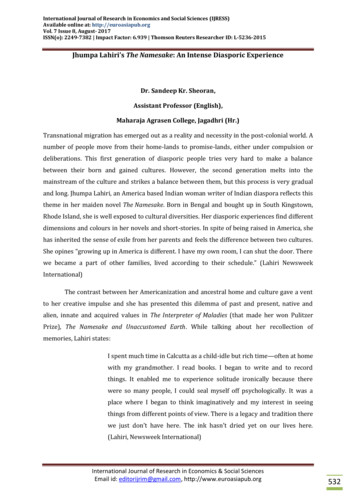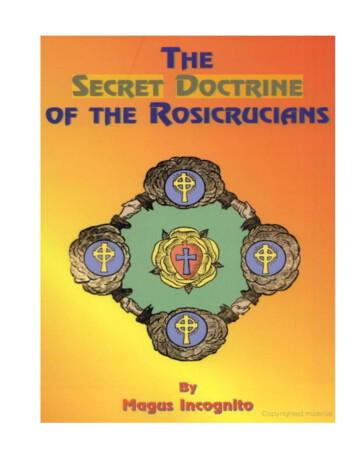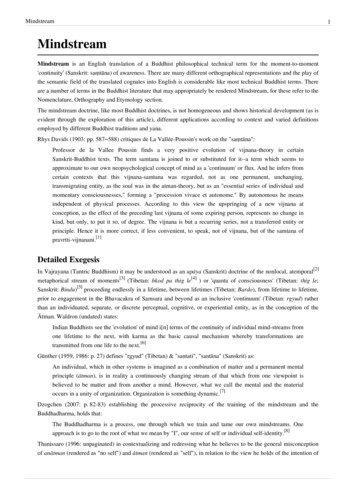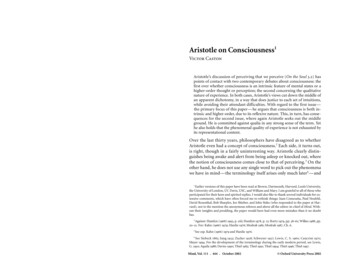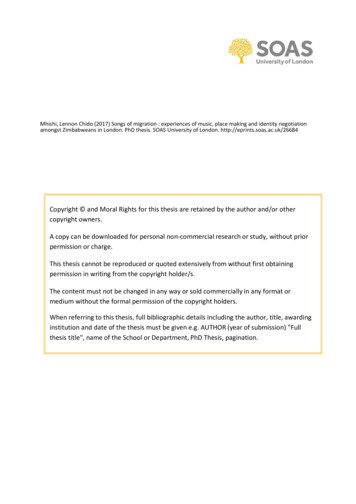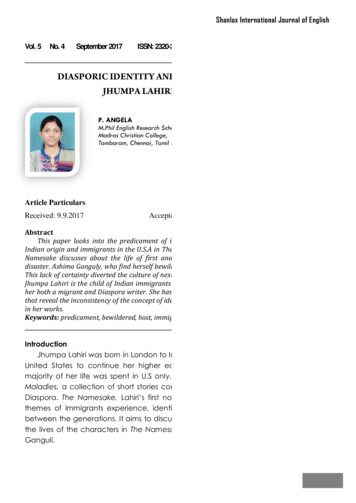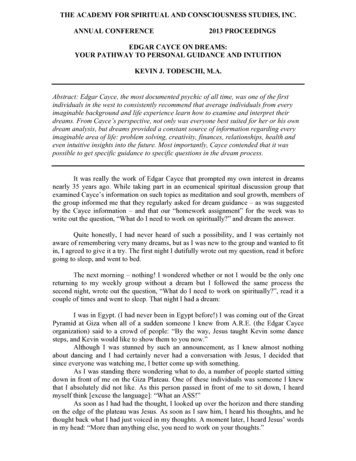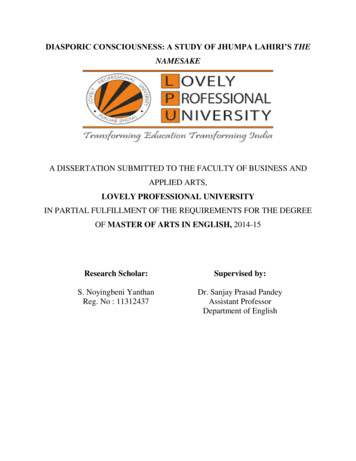
Transcription
DIASPORIC CONSCIOUSNESS: A STUDY OF JHUMPA LAHIRI’S THENAMESAKEA DISSERTATION SUBMITTED TO THE FACULTY OF BUSINESS ANDAPPLIED ARTS,LOVELY PROFESSIONAL UNIVERSITYIN PARTIAL FULFILLMENT OF THE REQUIREMENTS FOR THE DEGREEOF MASTER OF ARTS IN ENGLISH, 2014-15Research Scholar:Supervised by:S. Noyingbeni YanthanReg. No : 11312437Dr. Sanjay Prasad PandeyAssistant ProfessorDepartment of English
DECLARATIONI hereby declare that the dissertation entitled “Diasporic Consciousness inJhumpaLahiri’s The Namesake” submitted for M.A. degree is entirely my original work.All the ideas and references are duly acknowledged and it does not contain any other work forthe award of any other degree or diploma at any university.Name and Signature of the studentDated:S. NoyingbeniYanthan
CertificateThis is to certify that the work reported in the M.A dissertation entitled “DiasporicConsciousness in JhumpaLahiri’sThe Namesake”, submitted by S. NoyingbeniYanthan atLovely Professional University, Phagwara, Punjab, India is a bonafide record of heroriginal work carried out under my supervision. This work has not been submitted elsewherefor any other degree or diploma.Dated:Dr. Sanjay Prasad PandeyAssistant ProfessorDepartment of EnglishLovely Professional University
ABSTRACTThe present paper deals with the adequate issue of the migration to present the pain and theproblem that are faced by the immigrants by contrasting the subject of diaspora inJhumpaLahiri’sThe Namesake. In this paper we examine how Lahiri deals with subjectmatters like identity, dilemma, nostalgia and alienation faced by the immigrants. She presentsthe pain through her writings and this makes us understand the problems that are faced by theimmigrants. In The Namesake, Lahiri writes about the Indian immigrants who face alienation,nostalgia, dilemma and consciousness of being an outsider.In the first place, Lahiri in The Namesake, presents the character of Ashoke and Ashimawhere they feel nostalgia as they migrate to a new land and through the feeling of diaspora,they recollect the memories back at home especially in the character of Ashima. It also dealswith the cultural identity crisis which is faced by both the generation of the immigrants. In thecase of the first generation, the immigrants faces dilemma, consciousness of being an outsiderand cultural identity crisis due to the language, dressing essence and food habits. But thesecond generation immigrants they mainly face the crisis in relation to the personality,identity and adjustment in an alien land.In the period of globalization and with the fast moving of the development of technology,many people migrate to foreign land for one or the other reason but mostly for betteropportunities. In a way to connect and come closer to that place, but the closeness to theculture, the native language and the rules evoke a psychological oppression resulting todilemma of cultural clash and identity. JhumpaLahiri, a daughter of an immigrant is one ofpostcolonial writers who face clashes between the two cultures. Her very novel, TheNamesake, reflects the condition of the diaspora and the sense of alienation through itsBengali immigrant couple and their son, Gogol. Lahiri lays down by all means the feeling ofalienation through the adventures of her characters. The feeling of alienation is also shown inthe character from The Namesake in various forms. Thus the novel goes through deep into theimmigrants’ experiences of their problem with regard to the feeling of dilemma and diasporain the foreign land. This preoccupied feeling of nostalgia and alienation creates a sort ofimaginative writing. The following thesis presents an in-depth discussion of diasporicconsciousness on a greater scale.
Keywords: Nostalgia, identity, dilemma,immigrant, diaspora, andalienation.
ACKNOWLEDGEMENTAt the very outset, let me thank Almighty God for giving me this great opportunity tostudy and complete this project work on time.I am very privileged to express my sincere thanks and deepest sense of gratitude to myguide and mentor Dr.Sanjay Prasad Pandey, Assistant Professor, Department of English,Lovely Professional University Punjab. It is due to his valuable advices, splendid supervision,patience and focus that enabled me to shape this dissertation the way in which it is beenpresented. It was his vast knowledge, his expertise in this field and excellent guidance whichgave me the strength me to complete the task. His constant encouragement, unconditionalhelp and confident attitude has always been a moral support for me.I am very grateful to my parents for their constant help and understanding in all thematters, academic and personal. Dr.Anshu Raina, Assistant Professor Department ofEnglish, and Ms. PreetiPuri, my former guide and mentor, for their immense concern, vastexperience and sympathetic guidance throughout the journey of this dissertation. I am alsograteful to other faculty members of English Department for their support and concern.S. NoyingbeniYanthan
CONTENTSSr. No.TitlePage No.1.Chapter I: Diaspora: Issues and Perspective1-122.Chapter 2: Shaping Influences of the Writer13-213.Chapter 3: Diasporic Elements22-314.Chapter 4: Conclusion32-355.Chapter 5: References36-37
CHAPTER IDiaspora: Issues and PerspectiveOver the last few centuries there has been an increase of literature among members ofracialsectional groups and as well as among academics, surrounding the concept of diaspora.The word “Diaspora” has been derived from the Greekdiasperio which means to distribute. Itis a compound of sperio,to sow to scatter like seed and dia- from one end to the other. Theformation of earth after the expulsion of Adam and Eve from the Garden of Eden was theopening outlook in history, when this great odyssey of diaspora began. When the OldTestament was translated into Greek, the word diaspora was used to refer to the population ofJews exiled from Judea in 586 B.C by the Babylonians, and from Jerusalem in AD 136 by theRoman Empire.Twentieth century saw huge population movements. Some of these were due to naturaldisasters and some ensued because the people accepted, or could not avoid, the consequencesof political decisions (such as Stalin‟s desire to populate Eastern Russia, Central Asia andSiberia; or the transfer of millions of people between India and Pakistan in the 1947 partition).The term diaspora was thus integrated from Greek into English in the mid-20th century andrefers to anybody of people or ethnic population who are either forced or induced to leavetheir traditional homelands, the dispersal of such people, and the resulting developments intheir culture. The people having arrived in a new environmental and cultural situation, theytry to negotiate two cultures: one which they possess and the other the new one. The diasporicculture is essentially mixed and a unification of the two cultures.The Oxford English Dictionary(1989) defines Diaspora as anybody of people livingoutside their traditional homeland. Under Colonialism, diaspora is a mixedmovement;itinvolves the European‟s temporary or permanents movement in all parts of the world, whichfurther leads to colonial settlements. Consequently, the increasing economic exploitation ofthe already settled places necessitated large amounts of labor that could not be fulfilled by thelocal population. This led to diaspora resulting from the enslavement of Africans and theirremoval to places like the British colonies. After slavery was outlawed, the continued demand1
for workers created indentured labor. This produced large bodies of people from poor areasof India, China to the West Indies, Malaya, Fiji, Eastern and Southern Africa, and South EastAsia, etc.Diasporic consciousness is anintricate term as it contains idea including exilic existence; asense of loss; realization of being an outsider; longing for home; dilemma; burden of exile;dispossession and relocation.The first step out of one‟s country is a brave one and one has totake risk, because without it, one cannot hope to get anything. The lives of immigrants do nothave straight lines. They live centuries of history in a lifetime and have several lives andmoves. They experience a sense of up rootedness and un-belonging in the host countries. Inspite of their attempts of acculturation, they do remain at the outside and are treated as others.Diasporic people are formed out of the unification of accounts about journeys from the oldcountry to the new and where people belonging to the first generation immigrants incline toremember the old land or country more than the children born to the people of migrant.Salman Rushdie in the Imaginary Homeland: Essays and Criticism 1981-1991 statedmigrants to “straddle two cultures fall between two stools” and they suffer “a tripledisruption” (Rushdie 5) containing the loss of roots, the linguistic and also the socialdisplacement. Trishanku, an epic Indian character in Ramayana, who was neither accepted inheaven nor earth and had to settle midway between the two realm, serves as a metaphor forthe modern emigrant inhabiting the contested universalnative space.Bharati Mukherjee of the Jasmine fame has spent much of her career exploring issuesinvolving immigration and identity with a particular focus upon the United States and Canada.Shashi Tharoor‟s famous work is The Great Indian Novel (1989). His work as a UN officialliving outside India has given him a vantage point helps to construct an objective Indianness.Anywhere in the world diasporic groups are immigrants who recognize that theirtraditional homelands are reflected deeply in the languages they speak, religion they adopt,and the cultures they produce. They remember their past through memory, imaginary,narrative and fairytale and their search for ethnic individualitymake them as “individualswithout an anchor, without horizon, colorless, stateless, and rootless- a race of angels.” (Hall226) They are put in a state of „being‟ and „becoming‟ and they think of the differencebetween „what we really are‟ and that of „what we have become‟ as „the lost origins‟ in a2
foreign land.As a result, a new person is born as a diasporic person of the „New World.(Misra148)Diaspora identities are those which are constantly producing and reproducing themselvesanew, through change and difference. The spatial move contains a loss of territory andaddition of territory connected by journeys/travel. Diasporic writing across the world, in orderto make a wide overview is concerned with places, journeys and lands since diasporaencompasses a change of place through a journey. But what is also important is that the lossof land is almost always accompanied by the gain of new ones. In a way dislocation is alwaysfollowed by relocation.The maindistinguishing features of the Diaspora culture would include the followingthemes:1.The dilemma of the immigration2.The recollection of home including the details of childhood and the past events3.The clash of cultures and the twisted ties between generations4.The search for identity, moving and re-rooting5.The feeling of alienation in a new land and society6.A sensible attempt to emphasize cultural identity in terms of the homeland while at thesame time seeking acceptance in the new cultures.Diasporic writings explore the identities that are forged in the torment of several cultures,places, and races rather than just home and unknown land. Indeed, identity is not simply amatter of race but that identities are built through several: origin, race, gender, language,history. Diasporic writing, especially in the stage of globalization, is a perception raising sortwhere political issues of cultural nationality, multicultural fairness and worldwide inequalitygoes together with the themes of nostalgia, imaginative restoration of the homeland andidentities. Exile and displacement descriptionsoften combine a sense of concern with thefeeling of longing and recollection. Considerably diasporic writing explores the subject of anoriginal/unique homeland. This original homeland as now is lost due to their outcast/exile e/mythoftheindividual/communal. Nostalgia is therefore one of the maintheme in diasporic writing.3exiled
Samir Dayal‟s in his article, Diaspora and Double Consciousness “speculates on sometheoretical conjunctures between the concepts of diaspora and double consciousness”.(Dayal46) He also commented on the “contemporary debates about multiculturalism andtransnationalism demand and retaking of diaspora beyond the state-centrist model of eleganceto the host versus the whole country”. (Dayal46)Diaspora led to the flourish of literature. Many Indian writers who resides abroad orforeign lands tends to express themselves through creative writings. The scenario is quiteopposite as since earlier for an Indian writer to have a good perception of creative writing hewould often take the help of a foreign visitor to India.The Indian Diaspora writers wrote onloss of identity, feeling of isolation, sense of changes, flexibility, and movement. The themeof diaspora caters a very significant role in the Indian literature, and furthermore it helps tocontribute the theory of diaspora from a very general sense.From a broader perception we cansee that the study of such themes in literature like Diaspora helps us to gather aroundinformation on the cultural outlook between different countries. It provides us more vividinformation that borders different customs and traditions. Good fiction enhances facts andadds interesting layers to hold readers' attention and makes people aware about thecontemporary society. Likewise the subject of Diaspora advances some definite questionswhich embark the definition between homeland and foreign land. Thus Literature as being aproduct of culture becomes a great source which helps us to know about theworldwidesituation and multiculturalism. Another aspect of literature is to question the bondbetween the work of the writers and literatures of the country of their originand to observe thedifferent plans they adopt in order to discuss the cultural space of the countries of theiradoption. Thus literature works as a bridge which strengthens the bonds between India andother countries.Diasporic literature could be examined using several significant features. Firstly, it is basedon the knowledge of a homeland; a place from where the displacement occurs. Secondly,diasporic literature provides descriptions of rough journeys undertaken for various reasons.Thirdly, diaspora provides accounts of another intellect of place away from home land.Fourthly, one could read how homeland made characters behave in a far of land eitheraccepting or rejecting new cultural codes of their new intellect of place. Therefore, whenreading diasporic literature, we can learn how and why some people choose to migrate toanother country either voluntarily or due to other reasons, and how they get used to living4
peacefully elsewhere, but losing home and homeland. Diasporic literature may also signifyand examine with concepts such as nostalgia, memory and even lamentation of losing one‟sinherent language, homeland and friends and so on.It is an stimulating contradiction that a great deal of Indian writing in English is producednot in India but in widely distributed geographical areas of treaty (Indian Diaspora in theSouth Pacific, Caribbean, South Africa, Mauritius) and the contemporary Indian Diaspora inthe U.S.A., the U.K, Canada and Australia. They have dealt with diasporic consciousness intheir works with great comfort. The wave started with R.K. Narayan, Mulk Raj Anand but thetrend setter was Salman Rushdie. His Midnight‟s Children won the 1981 Booker prize andImaginary Homelands: Essays and Criticism primarily deals with the dilemma of immigrants.V.S.Naipaul, a third generation Indian from Trinidad and Tobago and a Noble laureate,writes about living in continuous exile and impossibility of ever having a home.BapsiSidhwa‟s Ice Candy Man at sociological level deals with the cultural complexities ofpost-independence Pakistani cultures and the diaspora they have occasioned. Amitav Ghosh‟scentral figures are travellers and diaporic exiles. The Shadow Lines makes a uniquecontribution to the debates over difference and otherness that have spurred the contemporarypost-colonial world. Anita Desai‟s Bye-Bye Blackbird is about migrant Indians in theEngland of 1960‟s. The protagonist Adit lives in London with his English wife Sara butsuffers from Identity crisis and finally decides to return to India.Tilo the protagonist of Dr.Chitra Banerjee Divakaruni‟sThe Mistress of spicesdispenses spices not only for kofta andcurry, but also for the homesickness and alienation that plagues the Indian immigrants thatutilize her dusty shop.Due to communication skills and willed immigration of people from their home of originin search of well lifeDiaspora has not been a new sense now just as exile or expatriate in ourglobalizing world. Diasporas are uprooted population leaving cultural and culturalderivationin a motherland other than where they presentlylive. Their financial, societal and politicalrelationships cross limits of nations. Diaspora studies presume the existence of displacedgroups of people who retain a collective sense of identity. The Indian Diaspora writer usedifferent literary forms and represent an extraordinary diversity of societies, languages, andreligious traditions. Emmanuel S. Nelson writes in the “Writers of the Indian Diaspora: ABio-Bibliographical Critical Sourcebook” that:5
Writers of the Indian Diaspora share a Diaspora consciousness generated by a complexnetwork of historical connections, spiritual affinities, and unifying racial memories, andthat this shared sensibility is manifested in the cultural productions of the Indian Diasporacommunities around the world. The element of homesickness, longing and a," Quest forIdentity" or "Roots" mark the Diaspora fiction.(Macwan46)As Terry Eagleton writes in, The Idea of Culture (2000) that the very word „culture‟contains a tension between making and being made most Diaspora writers concentrate ongenerational differences in exploring how new and old Diasporas relate to their land of originand the host culture. Often their major concerns in works are divided and flowing nature ofindividual identities. The rootlessness, coupled with the unconcerned attitude of host cultureadds to sense of otherness and isolation. Indians of almost all Diasporas have sought torecord the manner in which they have reformed to their environment. They have tried to provehow they have experienced both identification with new world and isolation from their oldhomeland. Jhumpa Lahiri has said, “The question of identity is always a difficult one forthose who are culturally disengaged, or immigrants with dual world.”(Macwan46) Due to thedislocation, Diaspora‟ssearch for identity, a sense of inability to belong becomes all the moredifficult and distressed. Diaspora's sense of loss becomes tragic when they think of returningto their homeland. The homes to which they want to return endures complete transformationand turns out to be a romantic deception. An immigrant longs for the world left behind in hisinborn land but does not manage to belong to neither world. When he sees a new place, hesees some connection to the old place, forever searching for his old home in his new home.His devotion, friendliness, culture are all a mix bag of old and new and always in anunclassified state. He lives a double life- his life outside his house; he tries, without quitesuccessive, to belong to the new world, while his life inside his new home, he attempts toimitate his old home, without much success either.The situation of a migrant is always in dual state in the beginning. While struggling to bestill on a foreign land, he is always portable. He is a migrant while trying to be motionless. Heis in transfer mode while struggling to settle down. He never knows how to balance in, alwaysgoing somewhere without getting anywhere. He tries very much to become a „new self‟,without really letting go of „old self‟. Metaphysically life of human beings turns out to be6
eternal outcast. Man does not have a lastinghome anywhere since his birth. Often life is calleda journey towards death. Coffin is considered as the final home. It is this dislocation whichgives Diaspora writing its strange qualities of loss and nostalgia. Alienation is anotherelement of Indian diaspora, it occurs in the life of all the people, either residing at foreignplace or at home, the effects of alienation is a universal phenomenon. Increasing acceptanceinto the host society does not show that the Diaspora characters can feel at home. Socialisolation is replaced by metaphysical isolation. Diaspora writing becomes significantbiographical sketch of the writers who describe in their writings an immigrant‟s effort tobelong to two places and fails to belong to either place, try to preserve hints of old identity,while struggling to obtain a new identity, lose both the identities in the process. As Rushdiehas said in Imaginary Homelands they are indulged to deal in broken mirrors, some ofwreckages have been lost. Literature emerging from the background of Diaspora has led totwo distinctive types of writing.The first of these is more narrative with references to the narration of self. The second ismore intellectual dealing with studies on Diaspora. And such features can be found in manydiasporic writings. Many of the works discuss the single/groups attachment to the homelandand the need to get accepted in the new settled area, this lead to a result of dualexistence. Amigrant, who has become now a stranger in his own lands, is also a stranger in the new lands.He is a man of many appearances while without belonging to any of those faces orappearances. Diaspora writing mostly becomes ananswer to the lost homes and to issues suchas displacement, nostalgia, discrimination, existence, cultural change and identity. Themigrant is uprooted, overturned and tries hard, without quite succeeding completely, to put hisroots down again. He tries to connect to the new world while not quite disconnecting from theold world. An immigrant, even though westernized, has a painful experience. He is upsetwith identity disaster; his native culture automatically interferes with the reasonableclutch offoreign culture. He has a tendency to do continuous remembrance, always imagining himselfin the old world as well-preserved and frozen in his memory. He is frozen in time, values,culture of the old world, a world which has since transformed and does not exist anymore; itlives only in his memory. He continues to adhere to the old world or at least to the idea of theold world. His sense of belonging to their homeland results in loneliness and feeling ofinsecurity. Identity and sense of displacement plays very important role in Diaspora writings.7
Monica Balyan in her article, Quest for the past in an Alien Land: A Study of JhumpaLahiri’s Namesake and Bharati Mukherjee’s Jasmine, speculates about the immigrants thatdraw them back to their roots. She also brings out how the “complication arises out in an alienland and how they start searching for roots in an alien land to find a meaning” (Balyan499)She also commented about the roots, the element of nostalgia, alienation and identity crisisbut she did not try to identify the similarities and differences that define the identity of atranscultural person.In The Namesake, identity crisis plays a vigorous role. The novel extents more than thirtyyears in the life of a fictional family, the Gangulis. The parents Ashima and Ashoke, eachborn in Calcutta, immigrated to the United States as young adults. Their children, Gogol andSonia, grew up in the United States and the novel examines the distinctions involve withbeing caught between two conflicting cultures with their highly distinct religious, social andideological differences. The novel uses Gogol‟s struggle over his name as a jumping off pointto explore large issues of combination, integration and cultural identity.Gogol, the protagonistis often in a confused state because of his identity, it is his name which symbolizes thedilemma of his identity. For instance in the novel when the students were taken to a graveyardfor projects Gogol after seeing the names encrypted on the tombstones wants to procure suchname so that he may feel more American. He feels that the only obstacle that is blocking hisAmerican culture was his name. Upon entering Yale as a freshman he replaces his name fromGogol to Nikhil. This name change makes him feel more American and confident. In Yale noone knows his real name,Gogol, he is known as Nikhil. Thus a metamorphosis occurs in hislife along with the new name. Gogol began to live a complete American lifestyle, he starts todo all those activities which he dare not being as Gogol. He even dates and American girl andshares in a live in relationship. Gogol habits tentatively changes from everything, his dressing,food, and even the minimal things of life and this was all brought about with him changing hisname to Nikhil. However the past still taunted him. He changes his name but “he does not feellike Nikhil” (Lahiri 105). Gogol is not completely cut off from his roots and identity. He triesnot to link up with his past and so he hides his past identity but with a fear of peoplediscovering it one day. With the rejection of Gogol‟s name, Lahiri rejects the immigrantidentity maintained by his parents. But this outer change fails to give him inner satisfaction.“After eighteen years of Gogol, two months of Nikhilfeels scant, inconsequential.” (Lahiri105) He hates everything that reminds him of his past and tradition. The loss of the old name8
was not so easy to forget and when alternate weekends, he visits his home “Nikhil evaporatesand Gogol claims him again.” (Lahiri 106).He was Gogol when his parents call him on phone.He tries to put a wall between his past and his present, but it is not easy.Study of the diasporic writings reveals that the common features observed in the writingsof the old diaspora and the new diaspora are nostalgia, homesickness, and the sufferings dueto being far off from their homeland. The mental disturbance and torture caused due to thepull and push factors of belonging to the land of adoption at the same time, retaining theircultural traditions thereby maintaining their attitude towards their motherland, made themreject everything Indian adoring west and criticizing India. The basic problem of diasporicwritings is the feeling of dislocation without roots. The Diasporas feel homeless and isolatedin the foreign land. Scattering of roots involves pain, alienation, identity crisis and otherfeelings to the uncultured ones.The experience of outcast, the tendency to remember the past may bring an uncertainty,which in turn determines a kind of writing that, excels geographical and national literatures.An exile writer at every step is called upon to imaginatively create and reconstruct his home,his roots, sometimes consciously and more often unconsciously while engaging in creativewriting. He has to search his tie-ups when he chooses to write while living among aliens in analien land, with an alien culture and in an alien tongue. They have an endless desire to return to their roots as the lost origins, which had the overwhelming nostalgia for times past.Such return to the beginning is symbolic representation of desire, memory, myth, searchand discovery which cultivates the sense of cultural identity in the diasporicwriters.theyappear as a broken self and sometimes appear as strangers to themselveswhich express their diasporic consciousness. (Misra 149)Most of the characters in diasporic literature according to Jaydeep Sarangi, suffer from cultural shock syndrome. It includes four sequentialpsychologicaldevelopments. First is the honeymoon stage- the initial admiration for the foreign culture.Then there is the crisis phase- when one discovers the socio-cultural and socio- linguistic9
differences. In this stage they suffer from a sense of anxiety and loss. The next is therecovery stage when the puzzle is resolved. In this phase, one tries to pick up alienconventions, including cultural and linguistic behavior. The last is that of the adjustment.In this stage one tries to overcome the preliminary shocks of alien culture. (Sarangi 142)Globalization and traditional hybridity are the fruits of large scale of diaspora. In recenttime, migration of people for work, research, freedom and materialistic life has brought theworld so close that national borders are just retreating and the whole world is shaping into aglobal village. From Gladstone coolies to the estates to computer code professions in SiliconValley, the Indian Diaspora has come of age as the educated, brainy tech Maharaja of theworld. The Indian diaspora is currently estimated to number over 20 million composed ofNRIs and PIOs.Collective memories of the original nation/homeland disturb the spaces of exilic writing.Postcolonial diasporic literature can be read as presented by looking backward to the past andfacing forward to the future. Looking backward at the past contains the wide use ofremembrances of the old country, that is the place of origin and home. Facing forward to thefuture contains a point of insecurity at the eventual of a new location and life. But however inmost of the cases, the memory of the old country is untrue in the sense that the exile tends tooverlay a memory that may not necessarily be adjacent with the real one. That is, the exileidealizes the old homeland through pictures and memories. Spatially speaking, displacementinvariably means a move away from home. But in a diasporic literature, it also means a movetowards another destination, perhaps anot
diasporic consciousness: a study of jhumpa lahiri’s the namesake a dissertation submitted to the faculty of business and applied arts, lovely professional university in partial fulfillment of the requirements for the degree of master of arts in english, 2014-15 research scholar
